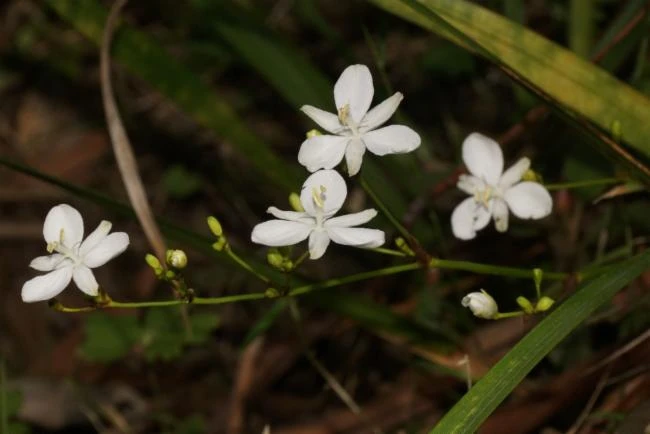Branching Grass-Flag
(Libertia paniculata)
Branching Grass-Flag (Libertia paniculata)
/
/

Gordon Deans
CC BY 4.0
Image By:
Gordon Deans
Recorded By:
Copyright:
CC BY 4.0
Copyright Notice:
Photo by: Gordon Deans | License Type: CC BY 4.0 | License URL: http://creativecommons.org/licenses/by/4.0/ | Occurence ID: https://www.gbif.org/occurrence/1935322147 | Publisher: Atlas of Living Australia |
















Estimated Native Range
Climate Requirements for Sierra Vista, Arizona
| This Plant | Your Site | Plant Suitability for Your Location | ||
|---|---|---|---|---|
| • Precipitation | 38" - 52" | 15" | Your precipitation may be insufficient for this plant. Irrigate N" / year. | Irrigate N" / year |
| • High Temp. | 74°F - 81°F | 94°F | Your summers may be too hot for this plant. | Too hot |
| • Low Temp. | 35°F - 45°F | 34°F | Your winter temperatures are normal for this plant | Excellent |
This plant should grow well at your location with about N inches per year (Y minutes per month) of irrigation.
Summary
Libertia paniculata, commonly known as Branching Grass-Flag, is an evergreen perennial herb native to open forests, grasslands, and along stream banks in Eastern Australia. It typically grows to a height and width of approximately 2 feet (0.6 meters), forming clumps of upright, sword-shaped leaves. The plant produces clusters of small, white, iris-like flowers atop slender stems in late spring to early summer, which are moderately showy and attract pollinators. After flowering, it may produce ornamental seed pods that add interest to the garden.
Branching Grass-Flag is valued for its architectural foliage and low maintenance requirements, making it a suitable choice for modern and informal gardens, as well as for mass plantings and borders. It is drought-tolerant once established and can handle a range of soil types, though it prefers well-drained soils. It thrives in both part shade and full sun, but in hotter climates, some afternoon shade is beneficial. This plant is generally disease-free but can be affected by snails and slugs. It is not known to have aggressive roots or to be particularly invasive when grown outside its native range.CC BY-SA 4.0
Branching Grass-Flag is valued for its architectural foliage and low maintenance requirements, making it a suitable choice for modern and informal gardens, as well as for mass plantings and borders. It is drought-tolerant once established and can handle a range of soil types, though it prefers well-drained soils. It thrives in both part shade and full sun, but in hotter climates, some afternoon shade is beneficial. This plant is generally disease-free but can be affected by snails and slugs. It is not known to have aggressive roots or to be particularly invasive when grown outside its native range.CC BY-SA 4.0
Plant Description
- Plant Type: Grass
- Height: 1.5-2.5 feet
- Width: 1-1.5 feet
- Growth Rate: Moderate
- Flower Color: White
- Flowering Season: Spring
- Leaf Retention: Evergreen
Growth Requirements
- Sun: Part Shade, Full Shade
- Water: Medium
- Drainage: Medium
Common Uses
Bird Garden, Butterfly Garden, Deer Resistant, Low Maintenance
Natural Habitat
Open forests, grasslands, and along stream banks in Eastern Australia
Other Names
Common Names: Grass Flag
Scientific Names: Libertia paniculata, Sisyrinchium paniculatum, Renealmia paniculata, Nematostigma paniculatum, Sisyrinchium paniculatum addenda, Tekel paniculata, Tekelia paniculata
GBIF Accepted Name: Libertia paniculata (R.Br.) Spreng.